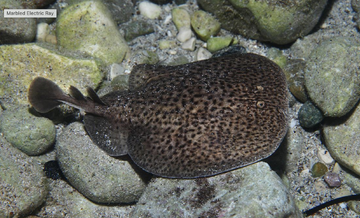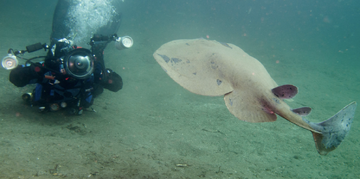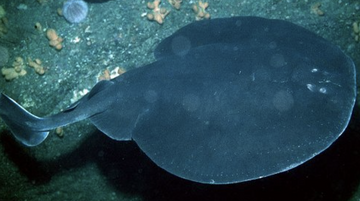Defining Features[]
Composing the order Torpediniformes, electric rays are a group of rays, flattened cartilaginous fish with enlarged pectoral fins. The body is thick and flabby, with soft loose skin with no dermal denticles or thorns. Torpediniformes possess many of the desired engineering features: propulsion by an undulatory tail (independent of the nonpropulsive body disk), a body disk housing a nonpropulsive payload, the electric organs, and high maneuverability in yaw and low-power station holding via benthic burrowing.
Habitat and Range[]
Torpediniformes are bottom dwellers of ocean floor, they bury under sand during the day and come out at night to feed. Torpediniformes can be found across the globe from British Columbia to central Baja California, to the Atlantic Ocean bordering Africa up to Norway, as well as parts of the Mediterranean. Specifically, electric rays can be found on sandy bottoms and around rocky reefs and kelp beds, at depths from 10–900 feet (3–274 m).
Fisheries Conservation and Concern[]
The status of many species is unknown because they live in deep waters. That being said, despite petitions, the National Marine Fisheries Service (NMFS) has concluded that electric rays, such as the Caribbean electric ray, do not warrant a listing on the endangered species register. Furthermore, pacific electric rays aren't in danger either. In continuation, due to the dangers of handling them, there is no sport fishing for these powerful rays.
Closest Relatives[]
Rhiniformes, Rhynchobatiformes, Pristiformes
Example Species in Torpediniformes[]

Marbled Electric Ray[]
Torpedo marmorata[]
Defining Features:
The black and brown speckled skin of these rays, resembling dark marbled floors, is ideal for camouflaging against the seafloor habitats where they live. As an ambush predator, the marbled electric ray will wait patiently in the dark hours of the night until they literally shock their prey with up to 200 volts of electricity.
Range & Habitat:
Marbled electric rays are commonly found in the eastern Atlantic Ocean bordering Africa up to Norway, as well as parts of the Mediterranean Sea. In rocky reefs and seagrass beds, the marbled electric ray buries itself in muddy bottoms during the daylight hours. Furthermore, these rays can have been known to live in waters up to 328ft deep.
IUCN Concern:
The conservation status of the marbled electric ray remains data deficient as defined by the IUCN Red List, but these rays are known to be a product of bycatch in some trawl fisheries and bottom longlines.

Pacific electric ray[]
Tetronarce californica[]
Defining Features:
Like the Marbled electric ray, the Pacific electric ray is known to shock and often kill prey with its powerful electric shock (45 volts). This powerful defense system certainly builds confidence in the Pacific electric rays, encouraging them to approach and even chase research divers. Furthermore, these rays can grow up to 4.5ft in length. (1.4 m)
Range & Habitat:
the Pacific electric ray can be found on sandy bottoms and around rocky reefs/kelp beds from British Columbia to central Baja California. Throughout these habitats, the rays can commonly be found at depths ranging from 10–900 feet (3–274 m).
IUCN Concern:
The conservation status of the pacific electric ray remains data deficient as defined by the IUCN Red List, but these rays are known to be a product of bycatch in some trawl fisheries and bottom longlines.
Example Species in the Gulf of Maine[]

Torpedo[]
Torpedo nobiliana[]
Defining Features:
Due to the rounded outline of its disk and the large caudal fin, Torpedo's are often identifiable at a glance. Furthermore, its skin is soft and naked, without the spines or thorns so characteristic of other skates within the Gulf of Maine. Along with their distinctive dark chocolate to purplish brown upper sides (White underbody), adult torpedoes can grow to about 5 feet long, and weigh heavy for their size. Like other electric rays, the Torpedo is known to shock its prey with up to 220 volts of electricity.
Range & Habitat:
Torpedo's can be found throughout both sides of the North Atlantic from southern Nova Scotia (La Have Bank), Bay of Fundy, and Georges Bank to North Carolina in the west; and from northern Scotland to the Mediterranean, Azores, Madeira, and tropical West Africa in the east. Atlantic Torpedo Ray are solitary in nature. They live in the water column at depths of 10 to over 2000 feet. Oftentimes, these rays hide on the seafloor during the day and come out to feed at night.
IUCN Concern:
Despite being considered "Least Concern," the Western Atlantic Torpedo Ray is nonetheless Red Listed. As of May 31st, 2019, these ray populations are decreasing.
References[]
Torpediniformes: Sciencedirect.com
Electric Ray: en.Wikipedia.org
Marbled Electric Ray: Oceana.org
Pacific Electric Ray: Montereybayaquarium.org
Torpedos: gma.org
Atlantic Torpedo Ray: Delaware.gov
Western Atlantic Torpedo Ray: iucnredlist.org